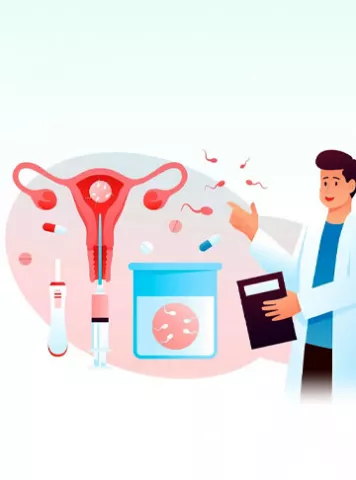What is Secondary Infertility?
Secondary infertility is defined as the inability to conceive or carry a pregnancy to term after successfully having one or more biological children in the past. Couples experiencing secondary infertility may have had a previous pregnancy without any significant issues, but are now struggling to achieve another pregnancy.
Who can get Secondary Infertility?
Secondary infertility can affect any couple, regardless of their previous reproductive history. Couples who have one or more biological children and are trying to expand their family may find themselves grappling with secondary infertility. It's essential to recognize that this condition does not discriminate based on age, ethnicity, or other factors, and it can affect both women and men.
What are the Types of Secondary Infertility?
Secondary infertility can be categorized into two primary types:
1. Temporary Secondary Infertility: In this type, couples may face difficulty conceiving for a limited period, often due to factors like stress, lifestyle changes, or temporary health conditions. Once these issues are addressed, fertility may be restored.
2. Permanent Secondary Infertility: This type involves more complex and long-lasting issues that hinder conception, such as advanced age, severe medical conditions, or irreversible surgical procedures.
What are the Causes of Secondary Infertility?
Understanding the underlying causes of secondary infertility is crucial for appropriate diagnosis and treatment. Some common causes include:
1. Age: As women age, their fertility naturally declines. This can affect their ability to conceive a second child.
2. Hormonal Imbalances: Conditions like polycystic ovary syndrome (PCOS) or thyroid disorders can disrupt hormonal balance and impact fertility.
3. Pelvic Inflammatory Disease (PID): Previous infections or untreated PID can lead to scarring and damage to the fallopian tubes, making it difficult for eggs to reach the uterus.
4. Male Factors: Male infertility issues, such as low sperm count or poor sperm quality, can contribute to secondary infertility.
5. Uterine Conditions: Fibroids , polyps, or other uterine abnormalities can interfere with embryo implantation.
6. Lifestyle Factors: Smoking, excessive alcohol consumption, obesity, and a sedentary lifestyle can negatively affect fertility in both men and women.
What are the Symptoms of Secondary Infertility?
Unlike primary infertility, secondary infertility may not present any obvious symptoms. Couples trying to conceive a second child might not notice any specific signs of infertility. Therefore, it's essential to consider fertility testing when efforts to conceive are unsuccessful for an extended period, typically one year for couples under 35 and six months for those over 35.
How is Secondary Infertility Diagnosed?
Diagnosing secondary infertility involves a comprehensive evaluation of both partners' medical histories and a series of tests. These tests may include:
1. Hormone Testing: Blood tests to assess hormonal levels in both partners, particularly estrogen, progesterone, and testosterone.
2. Ovulation Tracking: Monitoring the woman's menstrual cycle to determine if ovulation is occurring regularly.
3. Semen Analysis: A semen sample is analyzed to evaluate sperm count, motility, and morphology.
4. Hysterosalpingography: An X-ray procedure to assess the condition of the uterus and fallopian tubes.
5. Ultrasound: Imaging tests may be used to examine the reproductive organs for any abnormalities.
6. Laparoscopy: A minimally invasive surgical procedure to inspect the pelvic organs for issues such as endometriosis or scarring.
How is Secondary Infertility Treated?
Treatment for secondary infertility depends on the underlying causes identified through diagnosis. Common treatment options include:
1. Lifestyle Modifications: Encouraging healthier habits like maintaining a balanced diet, regular exercise, quitting smoking, and limiting alcohol intake can improve fertility.
2. Medications: Fertility drugs may be prescribed to regulate ovulation, treat hormonal imbalances, or stimulate egg production.
3. Intrauterine Insemination (IUI): This involves placing sperm directly into the uterus during ovulation to increase the chances of conception.
4. In Vitro Fertilization (IVF): IVF is an advanced procedure where eggs and sperm are combined outside the body and the resulting embryos are implanted into the uterus.
5. Surgery: Surgical interventions can correct issues such as uterine fibroids, polyps, or blocked fallopian tubes.
6. Donor Options: In some cases, using donor eggs, sperm, or embryos may be considered as a viable option.
Conclusion
Secondary infertility is a challenging and often overlooked issue that affects couples who have previously experienced successful pregnancies. It can be emotionally distressing, but with the right diagnosis and treatment, many couples can overcome this hurdle and achieve their dream of expanding their family. Seeking the guidance of a fertility specialist is crucial to navigating this complex journey successfully.
Articles
2023


Female Infertility Male Infertility
How many days Sperm Live in Female Body after Intercourse?
While it depends on the correct circumstances and the stage of the woman's men...
2023


What Causes High Estrogen in Women
Estrogen is a very important hormone in a female’s body. It is especially ne...
2022


Female Infertility Infertility Tips
Why do You Need Fertility Treatment
As we all know infertility rate is constantly rising in our society day by day...
2022


Female Infertility Infertility Tips
The Impact of Covid-19 on Pregnant Women & their Babies
Pregnant women and those in close-contact with them must take necessary precau...
2022


Female Infertility Infertility Tips
Is Covid-19 Vaccination dangerous for pregnant women? Know the Benefits and Risks
What do we know today about the benefits and risks of vaccination in pregnant ...
2022


Female Infertility Infertility Tips
We have sexually satisfied life , Still can we be infertile ?
Infertility is inability to conceive after one year or more with regular unprote...
2022


Infertility Tips Female Infertility
Should women go for IVF treatment?
Incidence of infertility in India is 10 to 15%, in other words 27.5 million co...
2022


Infertility Tips Female Infertility
IVF protocols for women with low ovarian reserve
Epilogue – low ovarian reserve Whenever we come across women with low ova...
2022


Female Infertility Infertility Tips
Does Alcohol & Smoking affect men’s fertility and sex life?
Infertility is a common problem affecting 17-20 percent of couples. It can be ...
2022


Female Infertility Infertility Tips
5 Do’s & Don’ts to Boost Fertility
Do you want a baby? Don’t be impatient: conceiving a child can take time....
Pregnancy Calculator Tools for Confident and Stress-Free Pregnancy Planning
Get quick understanding of your fertility cycle and accordingly make a schedule to track it














